
AMD’s Accelerated Processing Units (APU) has been a great alternative to a CPU + GPU setup when it comes to entry-level gaming. The fusion of a CPU and GPU into a single package was an enticing thought: it would save space as well as pass on the savings onto the gamers who would have otherwise bough a much more expensive setup.

Despite their ease of use and cheaper price, APUs have their downsides. Depending on the chipset you are using, there’s an option to include a sideport, which is essentially memory for the on-board GPU of the APU. Size is limited, however, which means that the VRAM for the APU has to come from somewhere; system RAM. APUs aren’t also the most powerful systems out there. Its performance was decent but it won’t replace a PC with discrete graphics card.
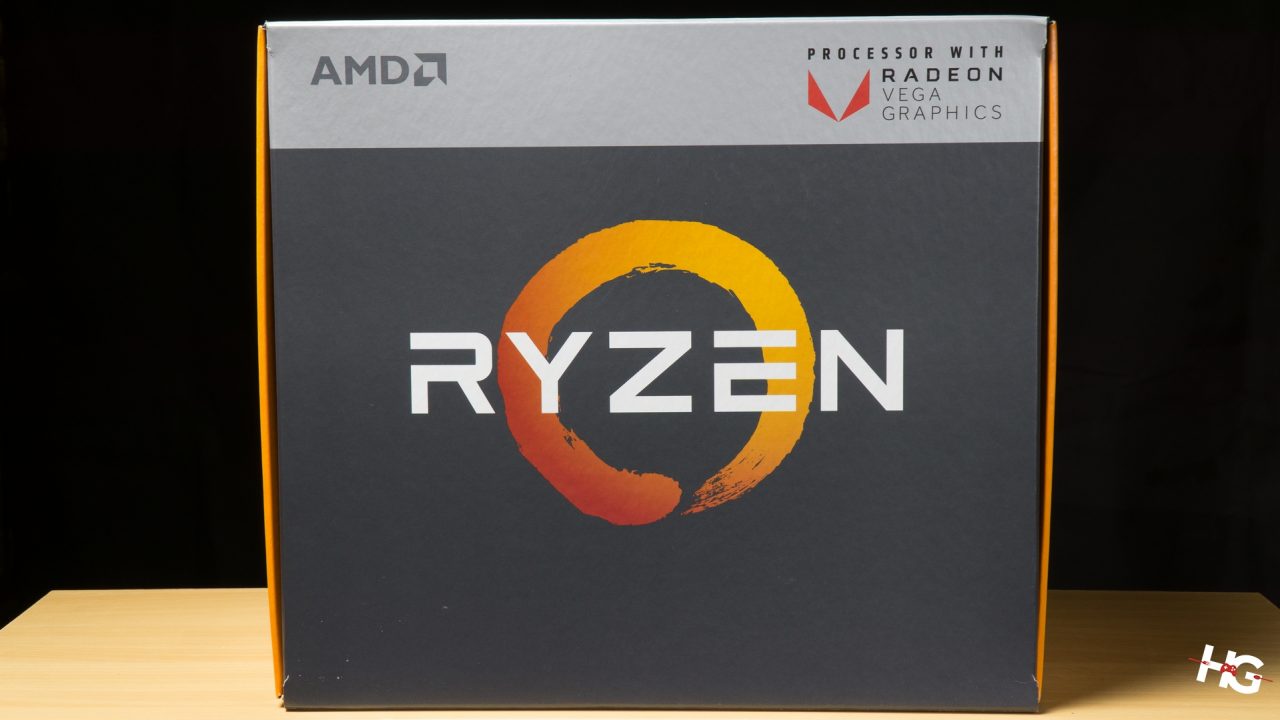
It’s been a couple of years since AMD has released a significant upgrade for their APUs. The last upgrade was back in 2016 under the code name “Bristol Ridge.” They have silently released new SKUs that work on their new AM4 platform, but these are nothing spectacular to talk about.
Ever since their re-emergence in the CPU market with Ryzen, it’s been only a matter of time until they update their line of APUs with a Ryzen-based APU. And the time has come just for that, in this review, we’ll be taking a look at AMD’s newest Ryzen-based APUs. Codenamed “Raven Ridge,” these new APUs sports Ryzen processors inside complemented by the company’s Vega GPUs.
| AMD Ryzen 5 2400G | AMD Ryzen 3 2200G | |
| CPU Cores | 4 Cores, 8 Threads | 4 Cores, 4 Threads |
| CPU Base Clock | 3.6GHz | 3.5GHz |
| CPU Max Boost Clock | Up to 3.9GHz | Up to 3.7GHz |
| GPU Cores | 11 Radeon Vega Cus | 8 Radeon Vega Cus |
| GPU Clock | Up to 1250MHz | UP to 1100MHz |
| L1 Cache | 64K | 64K |
| L2 Cache | 512K per core | 512K per core |
| L3 Cache | 4MB Shared | 4MB Shared |
| TDP | 65W | 65W |
| DRAM Supported | Up to DDR4-2933 (Dual Channel) | Up to DDR4-2933 (Dual-Channel) |
| Transistor Count | 4.94 billion | |
| TMUs | 44 | 32 |
| ROPs | 16 (32-bit) | 16 (32-bit) |
| FP32 Graphics TFLOPs | 1.76 | 1.126 |
| FP16 Graphics TFLOps | 3.52 | 2.252 |
| Render Backends | 2 (8px/clck @ 32-bit) | 2 (8px/clk @ 32-bit |
The AMD Zen Architecture and Raven Ridge

Courtesy of AMD.
AMD’s Ryzen processors are the first batch of CPUs to use their new Zen architecture. This new architecture boasts a massive leap in performance compared to the Excavator microarchitecture. Not only did AMD gain a huge 52% increase in instructions per cycle (IPC), they’ve also put in tons of work in the technology behind the Zen architecture.

Courtesy of AMD.
AMD was able to gain a 52% increase in IPS due to the design of Zen. Aside from the 1.75x larger instruction scheduler window and 1.5x better issue width and resources, Zen also uses a “neural network” to better understand an application. The AI, as AMD would like to put it, prepares CPU instructions so the processor is ready to take on a new workload.
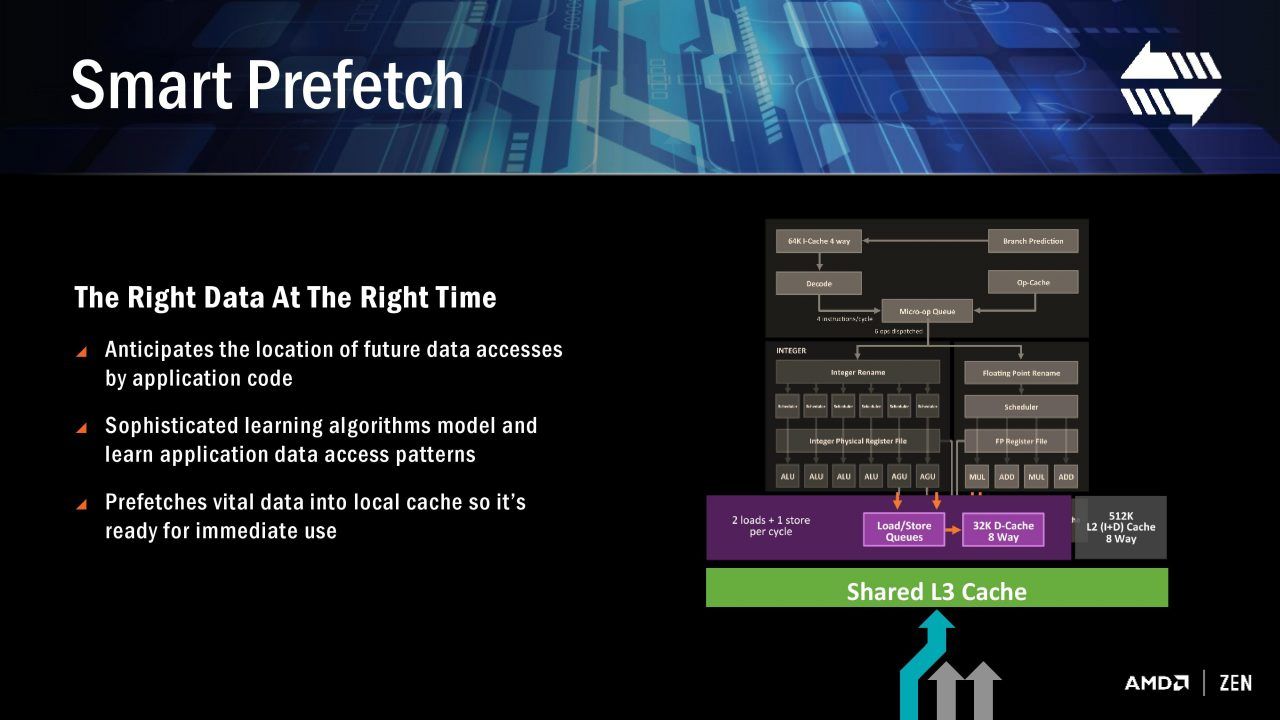
Courtesy of AMD.
This is further helped by the employment of Smart Pretech that anticipates and pre-loads data into cache in the CPU for faster and more responsive computing. The cache is also established at a lower level near the core to get up to 5x more cache bandwidth into a core. This allows Zen to essentially bypass L2 and L3 cache when using routinely accessed micro-operations.
The CPU Complex

Courtesy of AMD.
At the heart of every Ryzen processor is the CPU Complex (CCX). A CCX is a 4-core, 8-thread module, which has 64K of L1 I-cache, 64K L1 D-cache, 512KB dedicated L2 cache per core, and a shared 8MB cache across all cores in the CCX.
Since the CCX is the brain of a Ryzen processor (well, brains since there are more than one CCXes in one CPU), AMD has developed what the call an Infinity Fabric to allow the CCXes to communicate with each other to do meaningful work. This fabric allows the Ryzen to be scalable across all markets such as HPC, servers, HEDT to entry-level computing.

Courtesy of AMD.
The Infinity fabric also acts as a communication bus to allow the exchange of data between CCXes, system memory (RAM), and other devices such as PCIe bus, I/O, and storage. The only downfall of the Infinity Fabric is that it uses RAM to interconnect everything. Thus, you would need fast RAM with low timings for optimal processing performance.
Ryzen processors may also use Simultaneous Multi-threading (SMT). If you’re unfamiliar with SMT, it is essentially AMD’s version of Intel’s Hyper-threading, which allows applications to use multiple independent threads for faster execution. In AMD’s current Ryzen processors, the Ryzen 7 CPUs use a 4+4 setup with SMT for a total of 8-cores and 16-threads of processing power. Meanwhile, 6-core parts such as the Ryzen 5 range (1600X and 1600) use a 3+3 configuration with SMT for a total of 6-cores and 12-threads. In this case, the Ryzen 3 1300X uses a 2+2 setup, much like the Ryzen 5 1500X and 1400, however, the 1300X (and 1200) comes with SMT disabled. So, it’s basically setup like Intel’s i5 range, 4-cores and 4-threads.
AMD has opted to use a single CCX configuration in Raven Ridge, which means that the CPU’s cache has been reduced from 8MB to 4MB. Some games have benefited from the larger cache in a 2+2 configuration while some games performed better with the better latency of a single 4MB L3 cache. The final decision was made to make Raven Ridge a single CCX to make a more compact die for scalability for both mobile and desktop.
To further reduce cost, Raven Ridge only has x8 PCIe lanes compared to a more standard x16. This move was made due to public data showing that modern mid-range GPUs and workloads that are likely to be paired with Raven Ridge did not have any significant performance loss.
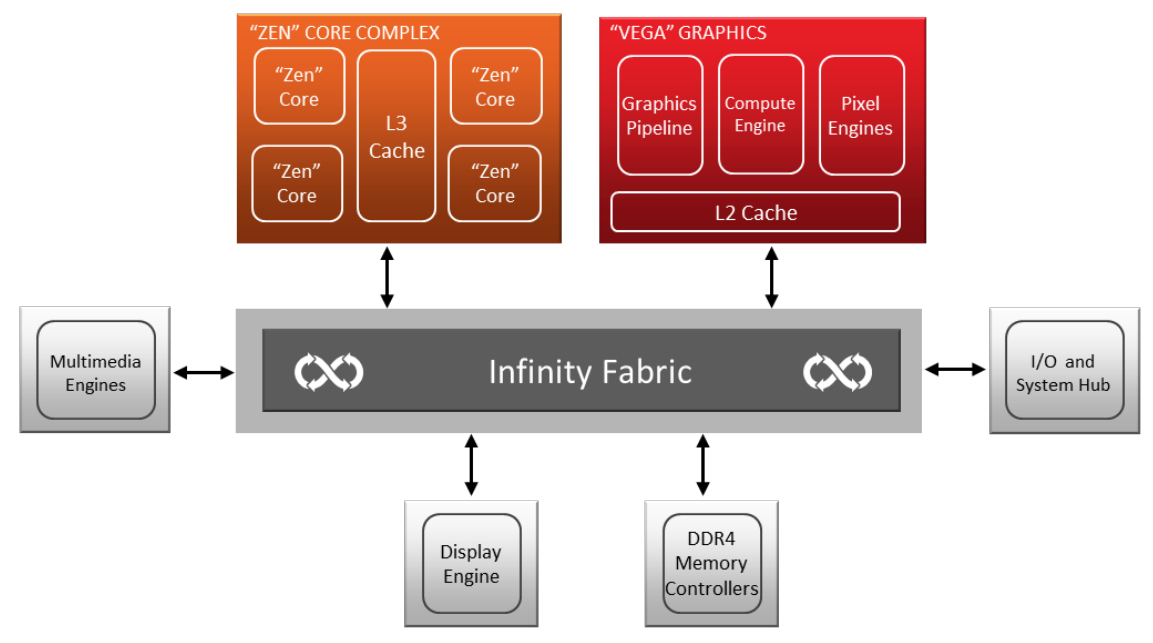
Courtesy of AMD.
As you’ve probably read in every Ryzen review, AMD’s Infinity Fabric almost holds the entire architecture together. The same is true with Raven Ridge. All the critical components are connected via the Infinity Fabric such as the CCX and Vega CPU in the APU.
AMD SenseMI

Courtesy of AMD.
With the help of the Infinity Fabric, AMD’s SenseMI allows its grid of sensors to push the performance of the CPU. According to AMD, their sensors are accurate to 1mA, 1mV, and 1°C, and are polled by the system 1000 times per second. These metrics are then read by the Infinity Fabric to make on-the-fly adjustments to the CPU on the current operating conditions.
Pure Power

Courtesy of AMD.
Every silicon is unique. It might need more power to achieve higher clocks or less power to get to the same clocks. AMD’s Pure Power reads data from the current usage of the CPU and uses that data to streamline power consumption while the CPU is working.
Precision Boost
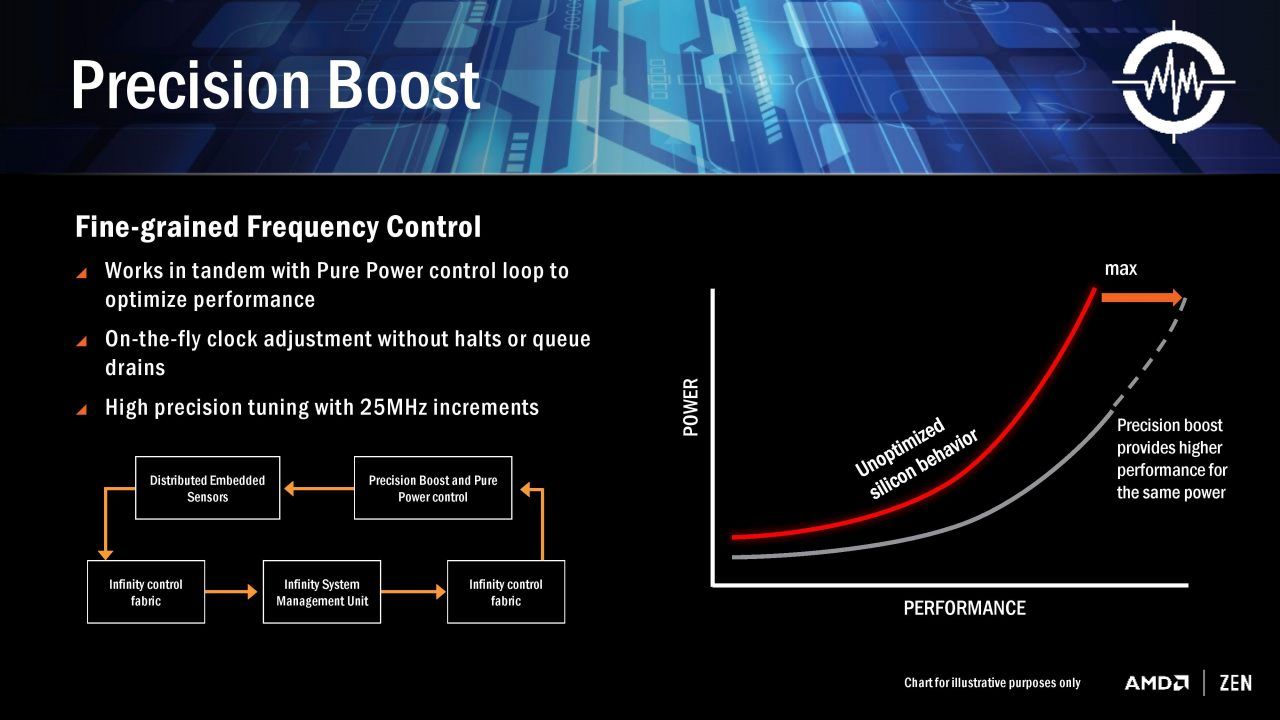
Courtesy of AMD.
Precision Boost gathers data from the Infinity Fabric and adjusts the CPU’s clock speeds in 25 steps. This allows Ryzen and other Zen-based processors in the future to finely tune their frequency target compared to Intel and older AMD processors which only have control over 100MHz steps.
AMD has implemented Precision Boost 2 in Raven Ridge, which is essentially a more efficient version of Precision Boost. This allows Raven Ridge APUs to have a linear boost algorithm that allows it to boost more cores, more often, on more workloads.
Extended Frequency Range

Courtesy of AMD.
With the help from all the telemetry gathered, AMD’s Extended Frequency Range (XFR) allows the CPU to overclock itself. Since not everyone is willing or know how to overclock, this is a better solution to get more from your CPU without manually overclocking your system. XFR, however, would need a more premium cooling solution to get the best out of your CPU.
Vega Architecture

Courtesy of AMD.
For the uninitiated, Vega is the latest GPU architecture from AMD. Vega was made with several principles in mind: flexible operation, support for large data sets, improved power efficiency, and scalable performance.
Next-Generation Geometry Engine
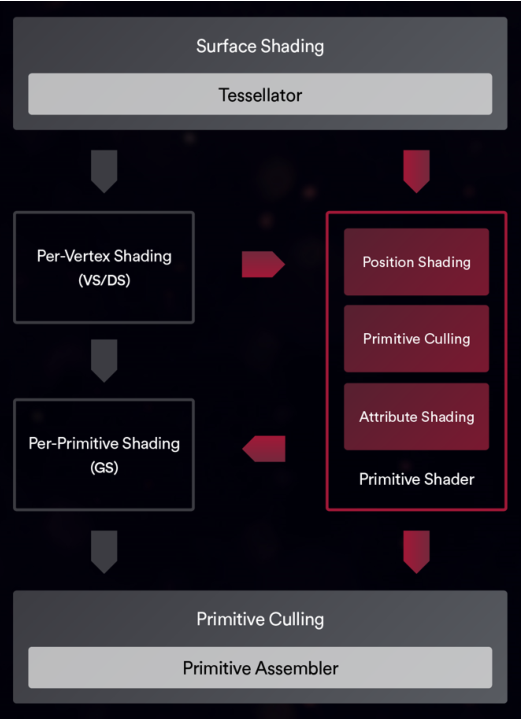
Courtesy of AMD.
To provide better performance in both professional and gaming applications, geometry engines have been improved by adding new fast paths through the hardware and avoiding unnecessary processing. This allows it to have higher polygon throughput.
AMD’s new geometry engine uses “primitive shaders” as a keyelement in its ability to achieve higher polygon throughput per transistor. Without being too technical, these primitive shaders allow parts of the geometry pipeline to be combined to become a more efficient shader type. This also allows to Vega to only render the visible parts of the geometry, which means more performance dedicated to what you’re seeing.
The new AM4 socket
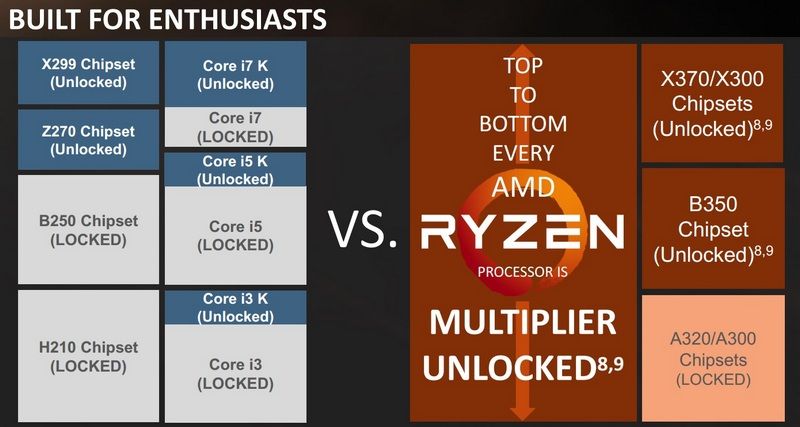
Courtesy of AMD.
Meant to house their new Ryzen CPUs, the AM4 platform was co-developed by ASMedia. It currently consists of five chipsets that’s meant to be paired with the new 1331 socket. This new socket still uses PGA (Pin Grid Array) instead of LGA (Land Grid Array), which means that the pins are still connected to the CPU instead of the motherboard which Intel has been using for many years now.
Aside from Ryzen, AMD’s soon-to-be-released Raven Ridge APUs can also be used with the AM4 chipset, which is why we’re seeing display ports on some AMD motherboards even if the current Ryzen CPUs doesn’t have any on-die GPUs
As expected, the brand new chipset supports high-end features such as NVMe PCIe 3.0 x4, SATA III, SATA Express, Dual Channel DDR4, native USB 3.1 Gen2, and more. Check out AMD’s table below to see how each chipset compares with one another:

Courtesy of AMD.
Apart from high-end features, the AM4 platform also uses a different heatsink mounting system compared to the old AM3 platform. The bolt-through mounting system has been widened to house the 1331 socket. Mounting clip-style coolers on the motherboard, however, should not pose any problems. Coolers with their own mounting system might have problems. You might need to purchase another cooler or contact your heatsink brand to check if they can send you an AM4-compatible mount.
Let’s get on with our review of the Ryzen 5 2400G and Ryzen 3 2200G.
Up close with the Ryzen 5 2400G and Ryzen 3 2200G
Both the Ryzen 5 2400G and Ryzen 3 2200G comes in a package reminiscent of a Ryzen 3 CPU. It’s not a surprise since both these APUs are targeted to entry- to mid-range users. Both APUs have a TDP of 65W and each comes with a Wraith Spire as their heatsink.
Ryzen 5 2400G
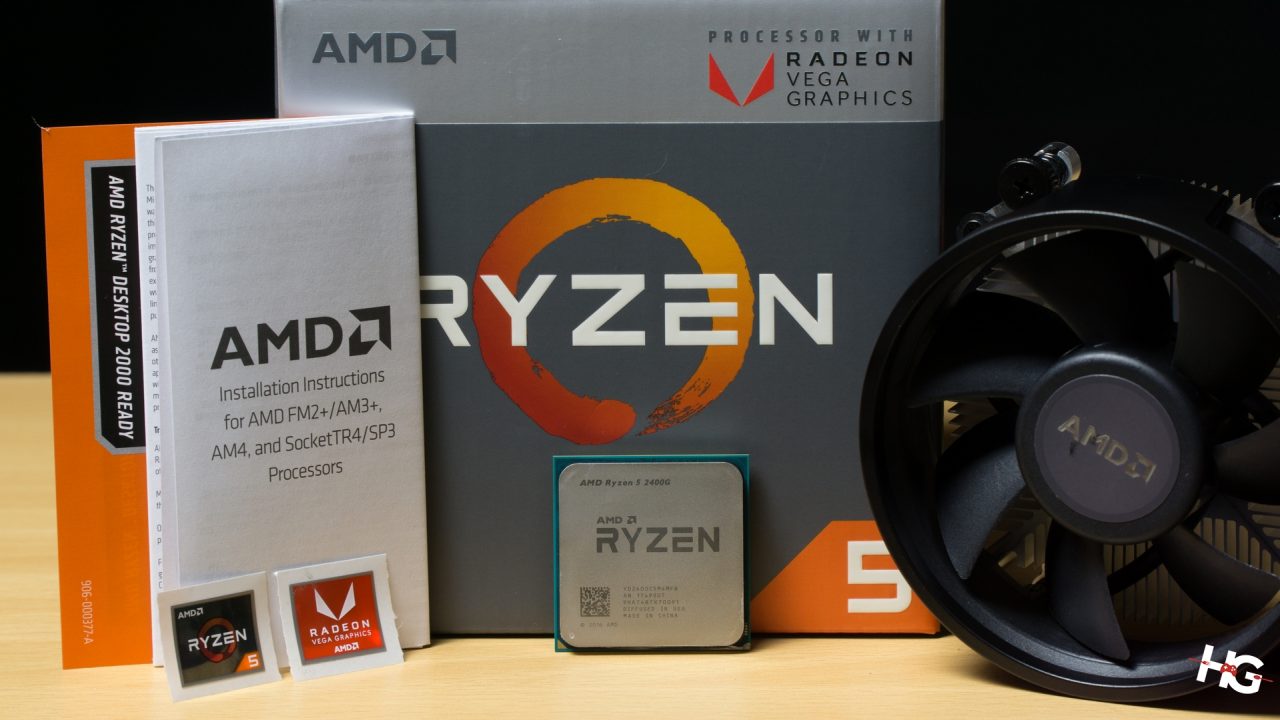
The higher model of the two, the Ryzen 5 2400G sports a base frequency of 3.6GHz and a max boost frequency of 3.9GHz. Inside are four physical cores provided by the single CCX with a 4MB shared cache. Since this is a higher-end part, AMD has enabled SMT on the 2400G. Allowing it to have 8 threads instead of four. The 2400G also comes with 11 Radeon Vega Compute Units that clocks up to 1250MHz.
Ryzen 3 2200G
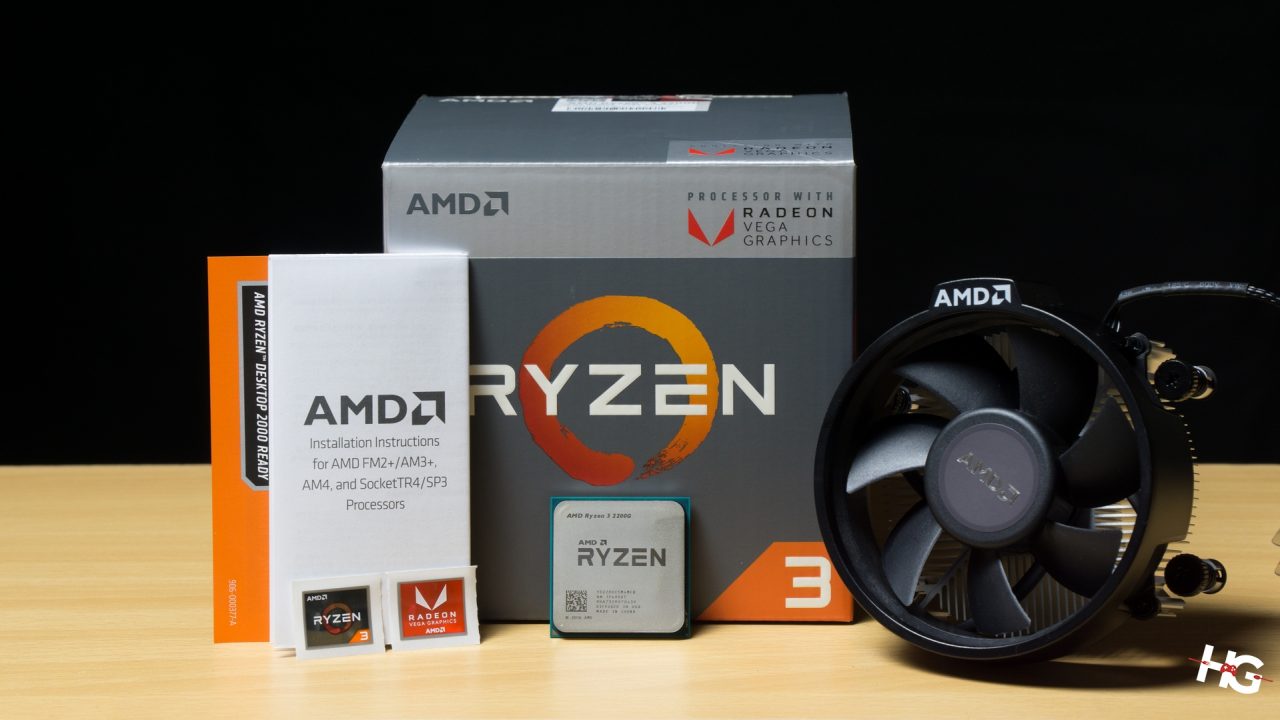
The Ryzen 3 2200G is clocked at a base of 3.5GHz and can reach up to a maximum boost clock of 3.7GHz, which is a decent 200MHz below the 2400G. The 2200G, however, has SMT disabled, which means that it has 4 physical cores and 4 threads with 4MB of shared cache. The GPU core has been lowered as well to 8 Radeon Vega Compute Units, which is three compute units less than its bigger brother.

The Vega cores inside both APUs uses DRAM as its VRAM. To adjust the RAM usage of the APUs, you’ll only need to go inside the BIOS.

In our motherboard, which is a Gigabyte AB350N Gaming WiFi, you’ll need to locate the Peripherals tab and go in to AMD CBS where you will find NBIO Common Options.
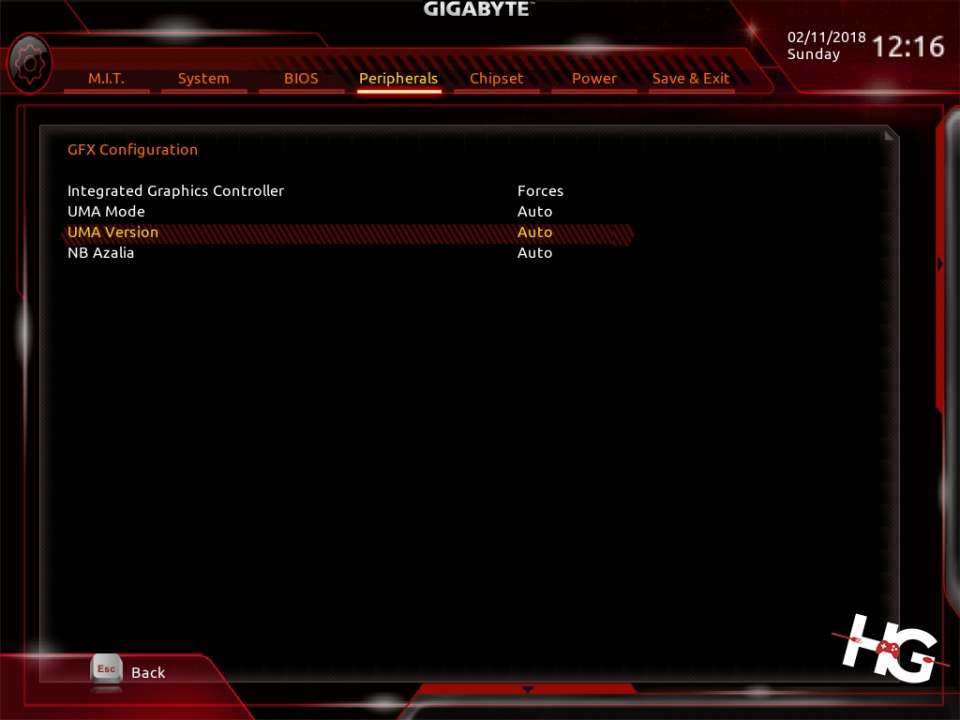
Inside is a couple of options. Go in to GFX Configuration where you’ll need to change to option on the Integrated Graphics Controller to “Forces,” which will let you access UMA Mode.
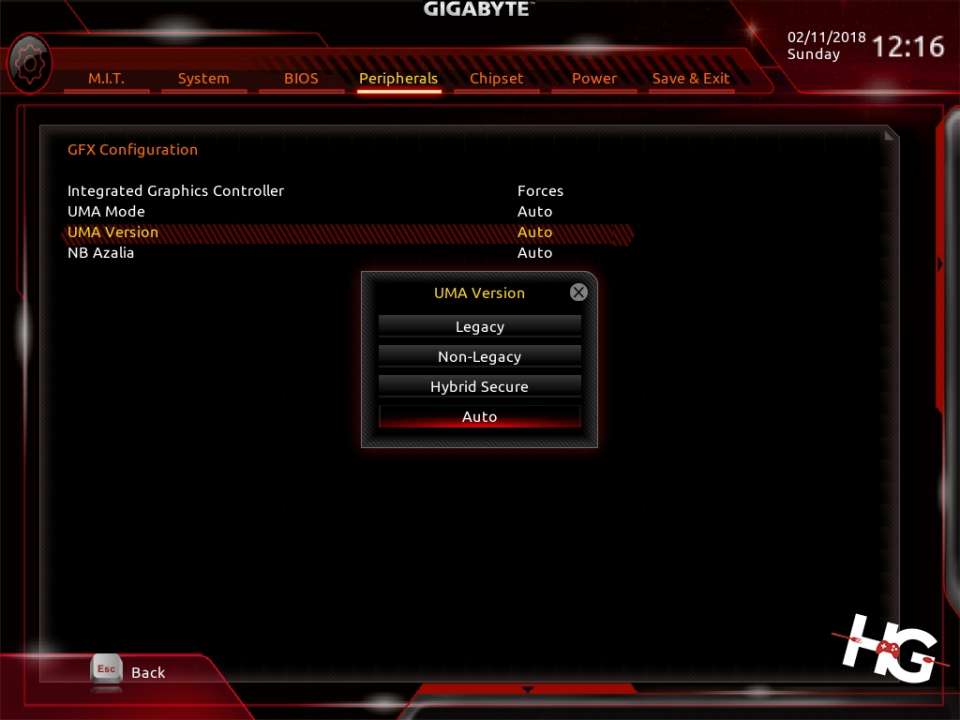

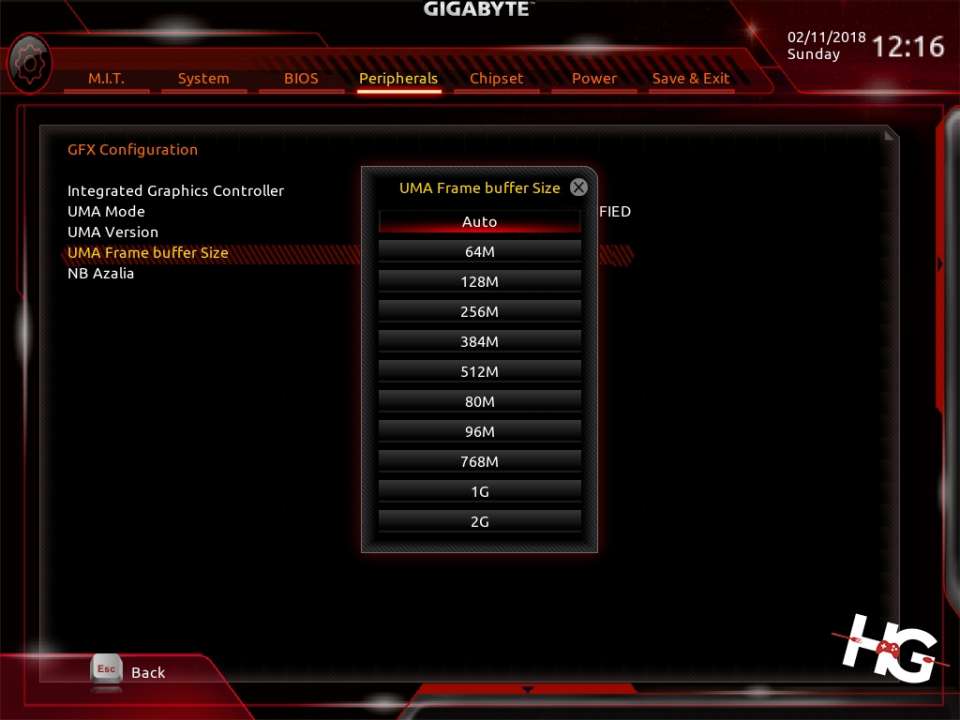
Choose UMA_SPECIFIED, which will make the UMA Frame Buffer Size option to appear. From there you can choose the size of the RAM that’s going to be used by the APU. When left to its own devices, the APU will automatically allot 1GB of VRAM to the GPU cores. Choosing your own VRAM size can be helpful when you’re trying to improve performance of your GPU.
System, Overclocking, and Benchmarks
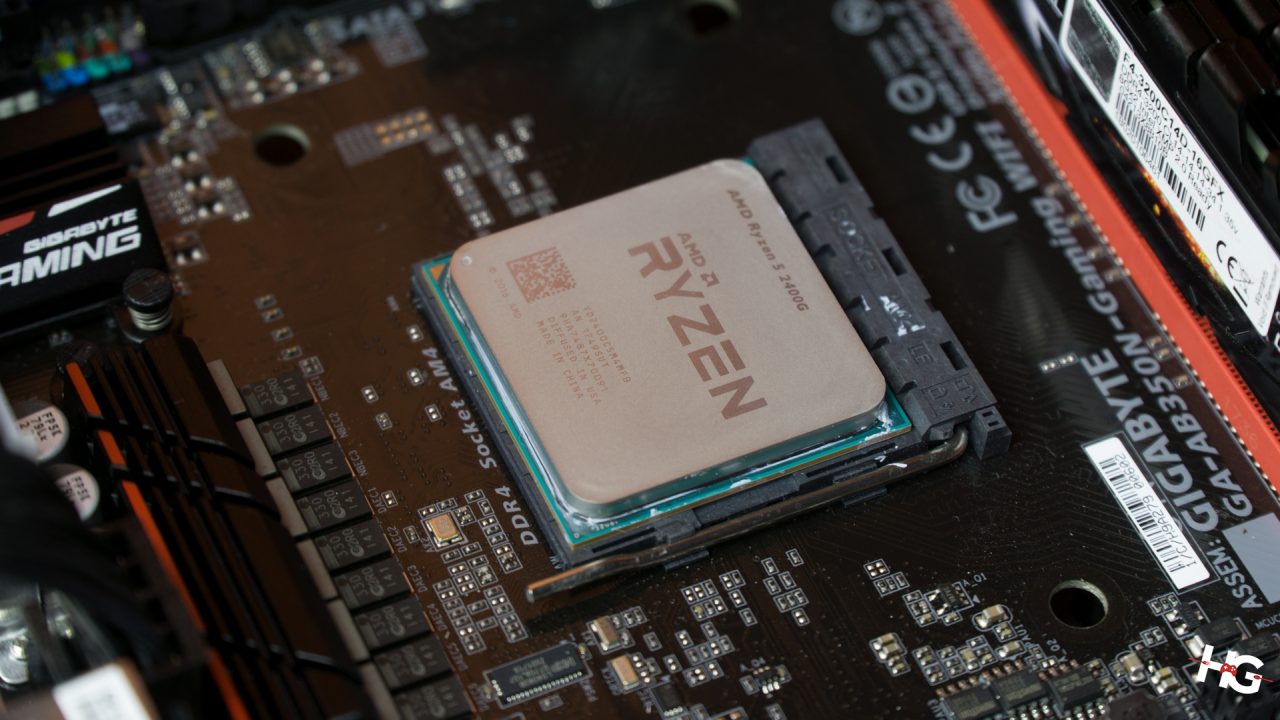
Most of the components used to review the Raven Ridge APUs were provided by AMD. So some of our usual components such as our motherboard and RAM are not present in this review. Here are the setup we used to benchmark both the Ryzen 5 2400G and Ryzen 3 2200G:
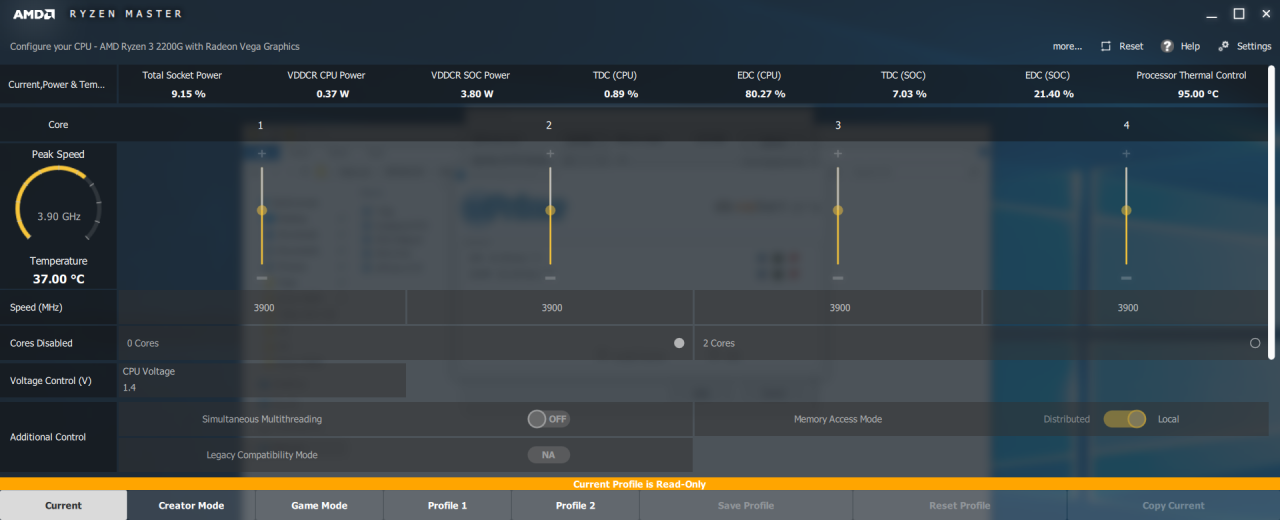
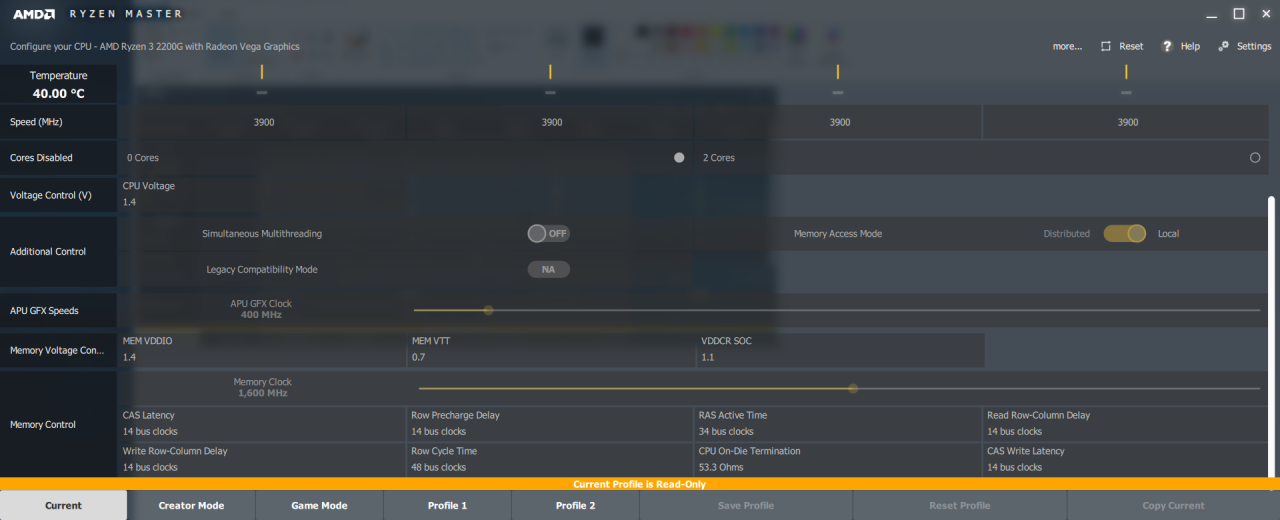
Overclocking any of Ryzen processor can be done at an OS level via AMD’s Ryzen Master. It works decently enough. There are individual sliders for each cores and important monitoring information such as temperature, socket power, and voltage are displayed. You can even set custom profiles via the program.
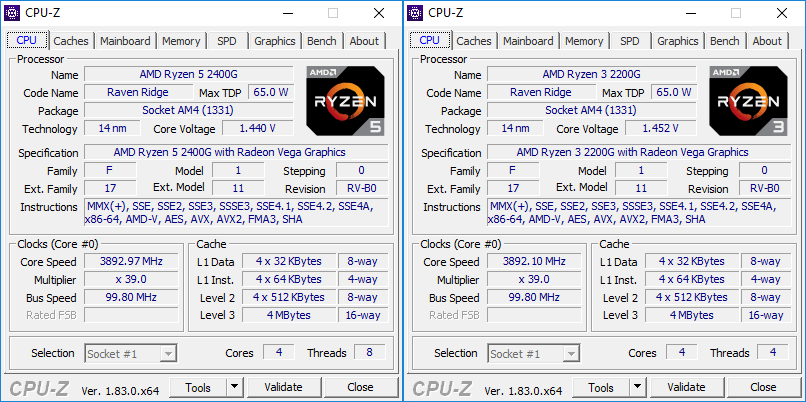
We’re most comfortable, however, overclocking from the BIOS. Both the 2400G and 2200G was able to reach a core clock of 3.9GHz on all cores at 1.44v and 1.45v, respectively. We did expect that both processors would at least reach 4.0GHz. But alas, we weren’t lucky in the silicon lottery.
System Benchmarks
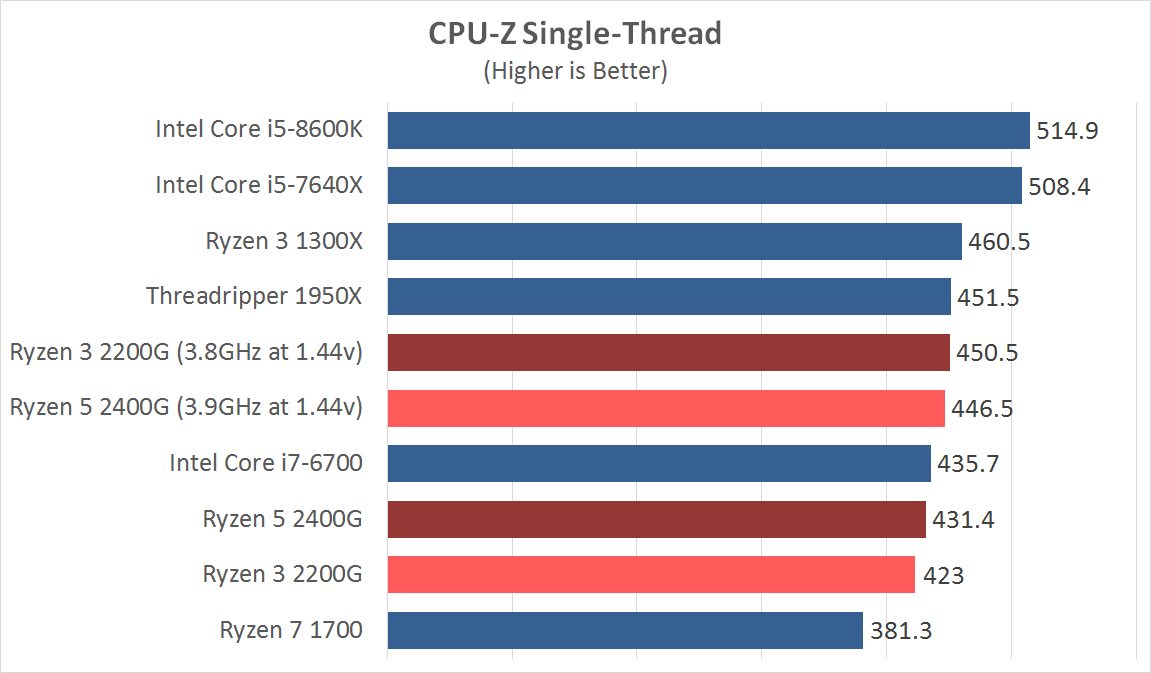

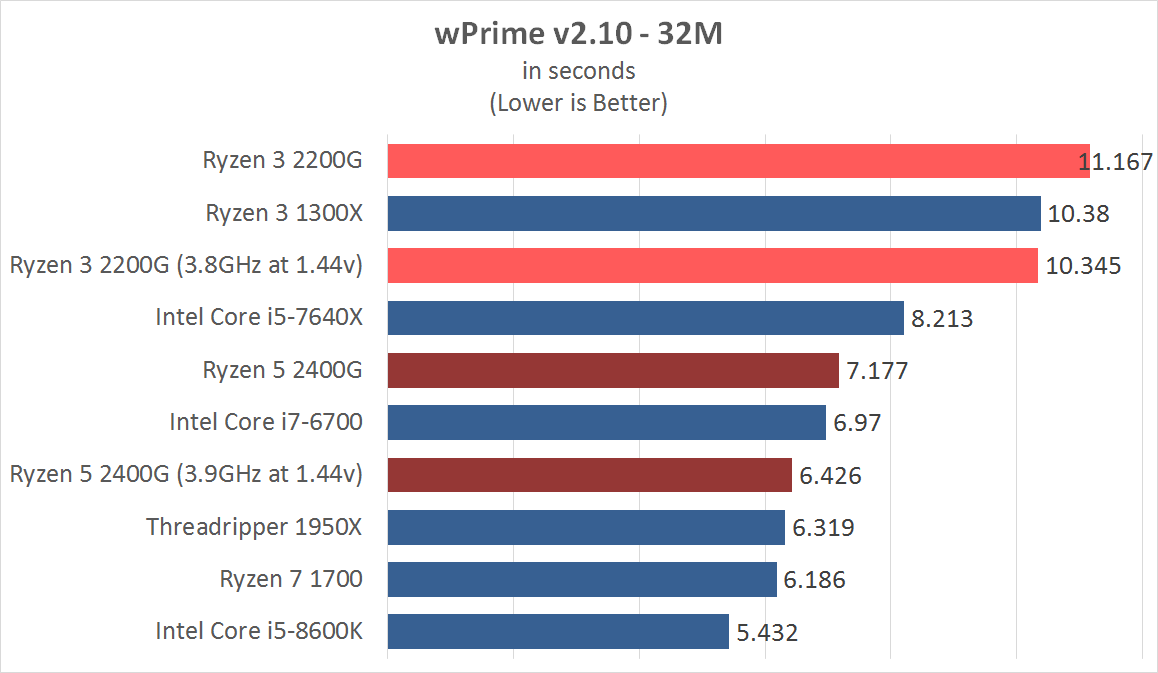
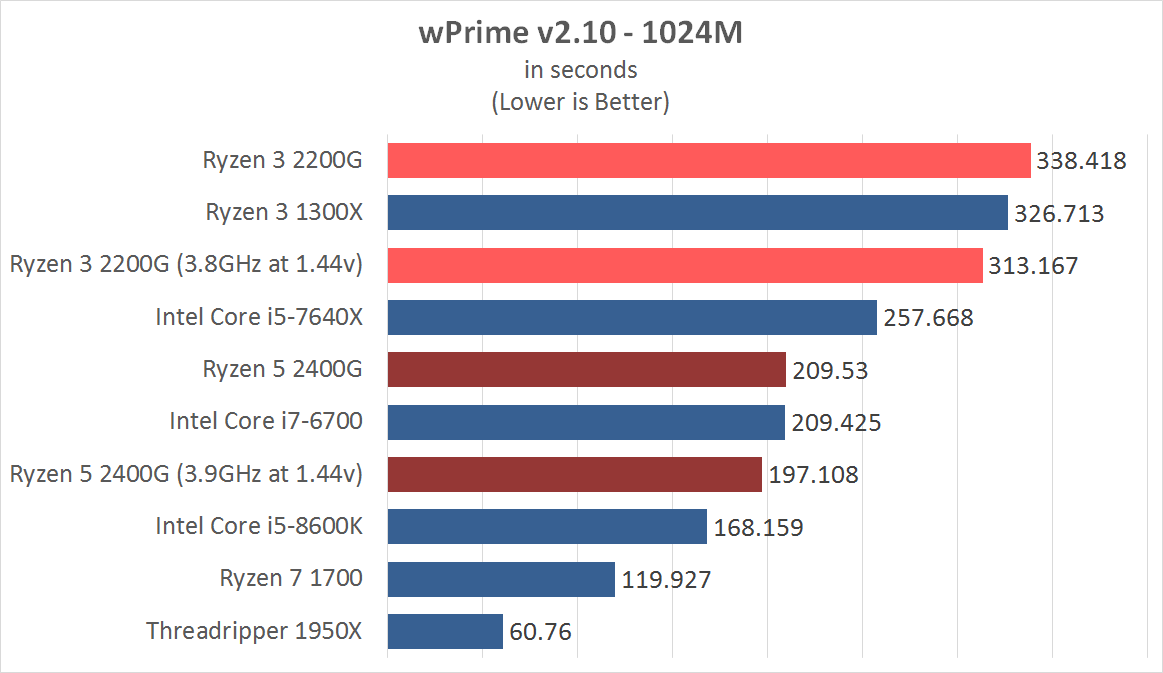
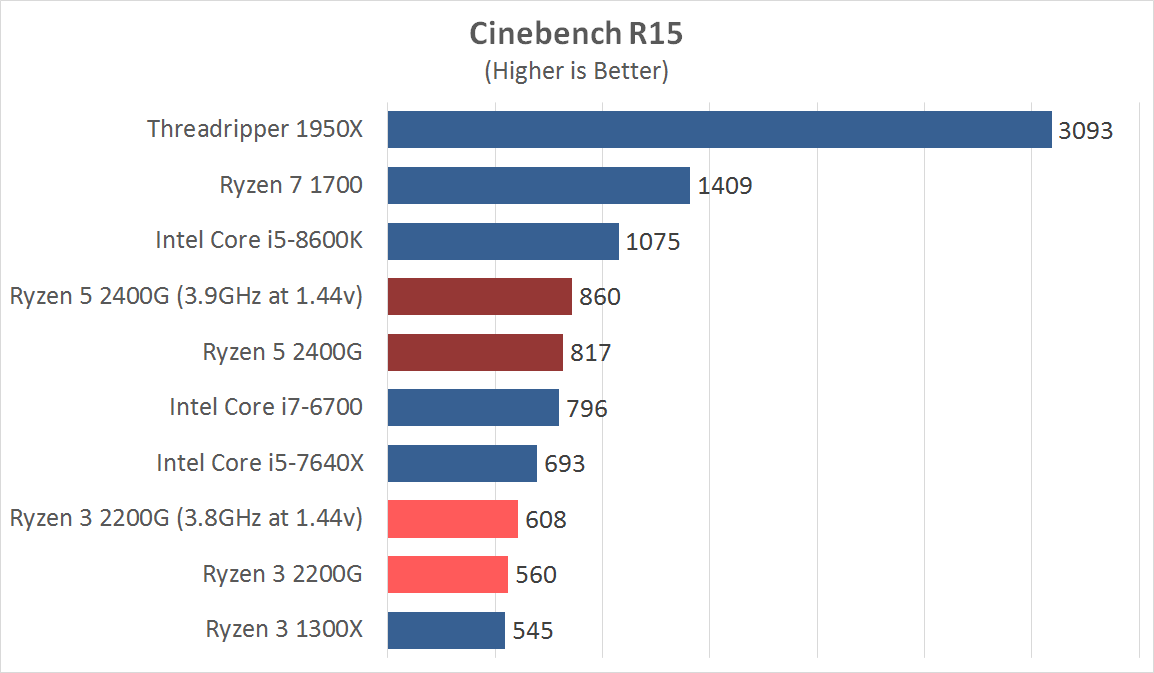
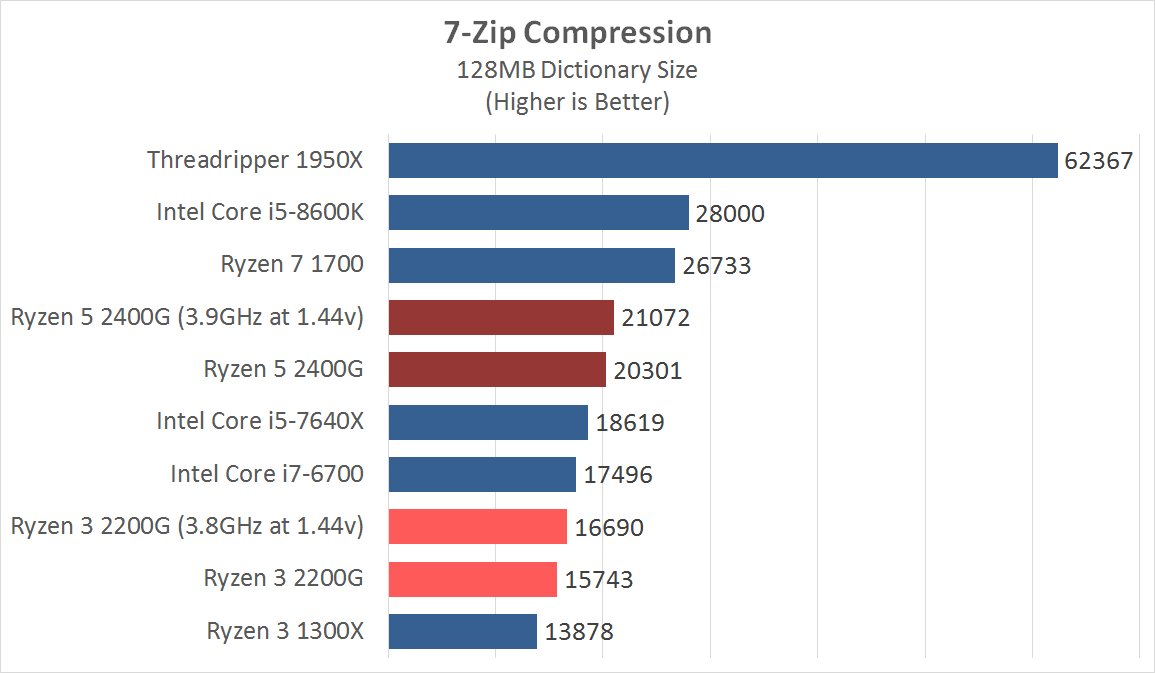
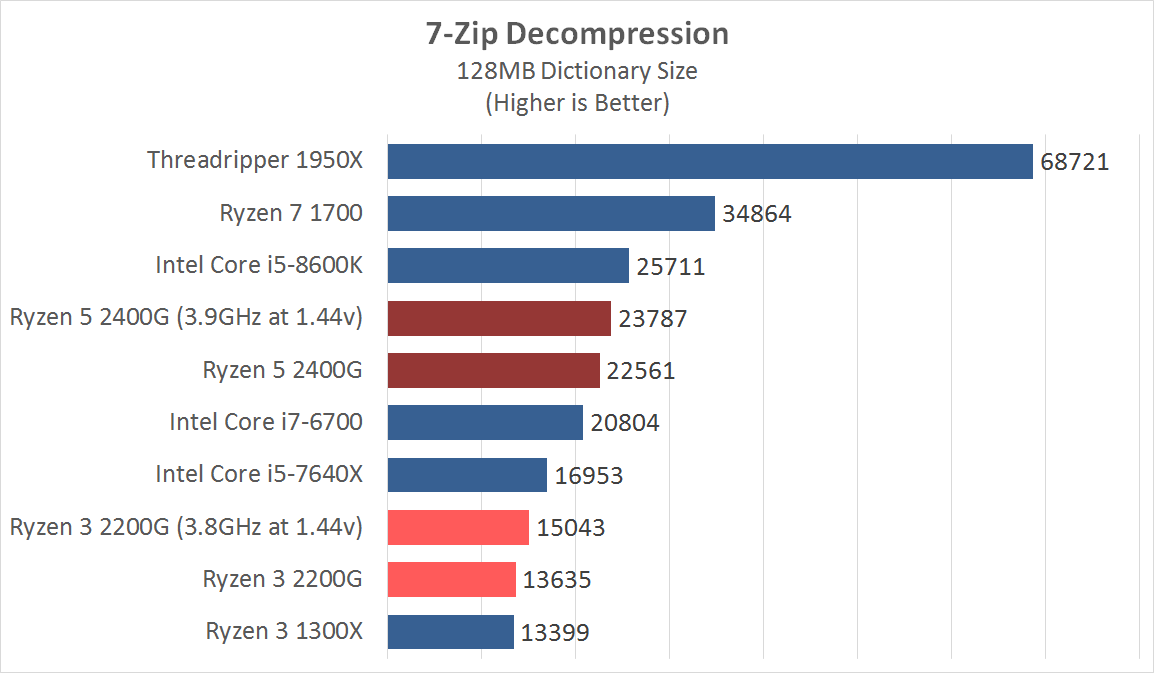
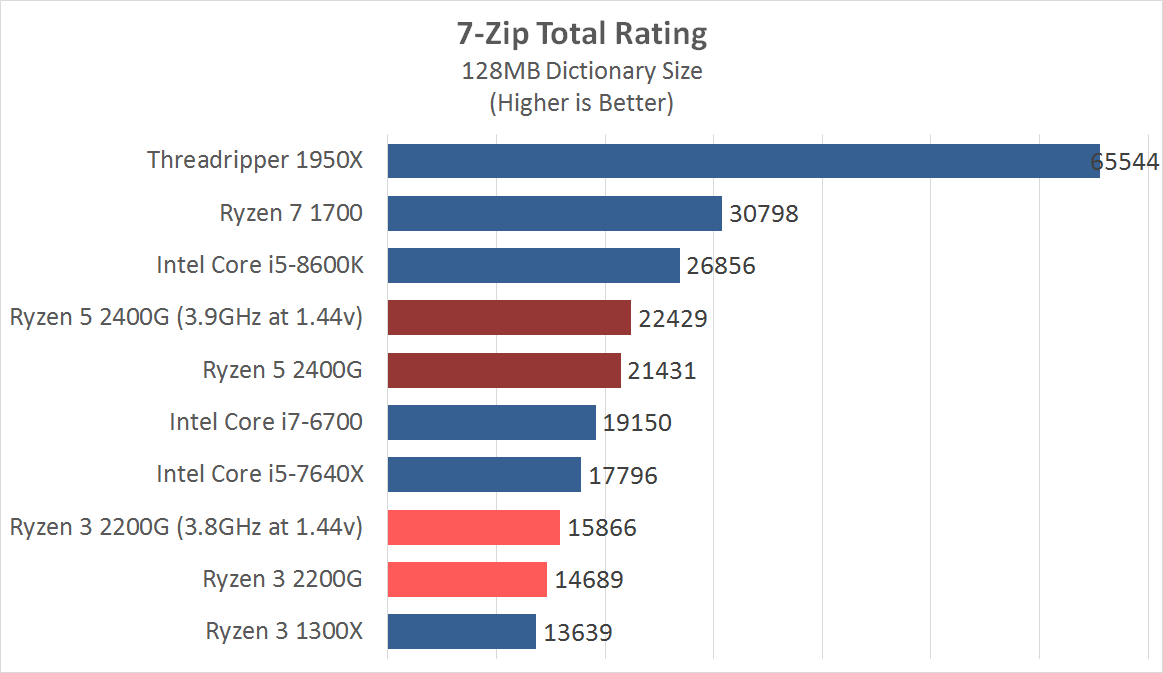
As expected, the 2400G and 2200G scaled linearly compared to other Ryzen-based processors. Both APUs traded blows against the Ryzen 3 1300X, which is also a processor targeted at the budget audience. Overall, it’s pretty much what we expected from both APUs.
Gaming Benchmarks (1080p)
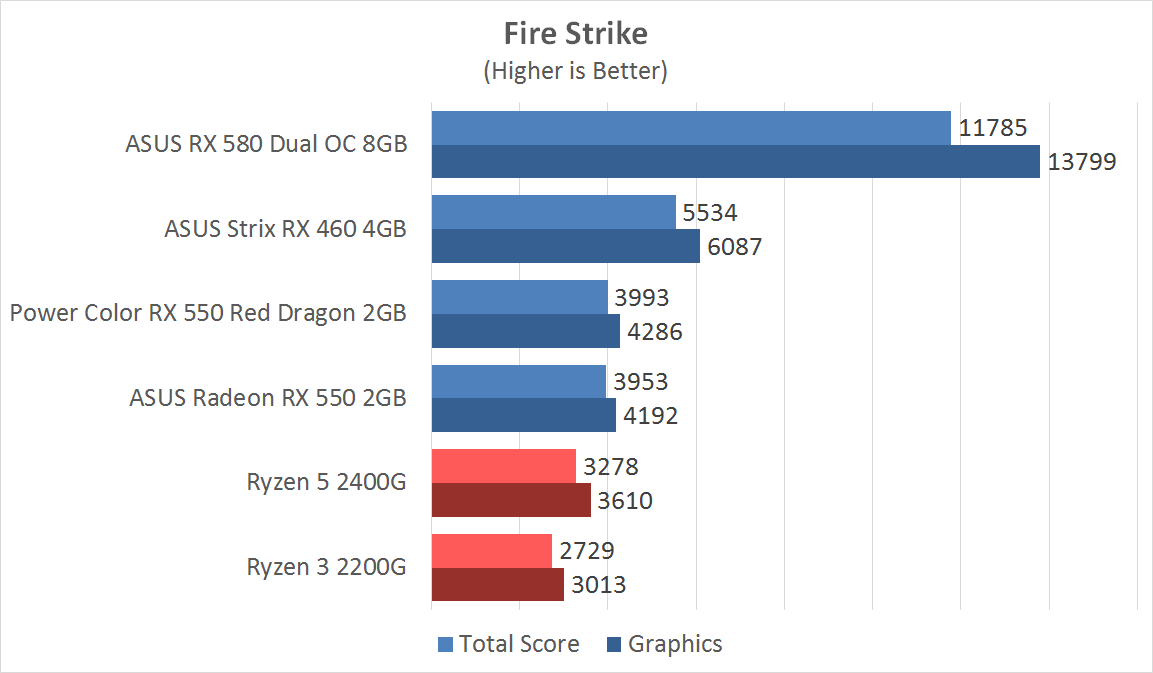
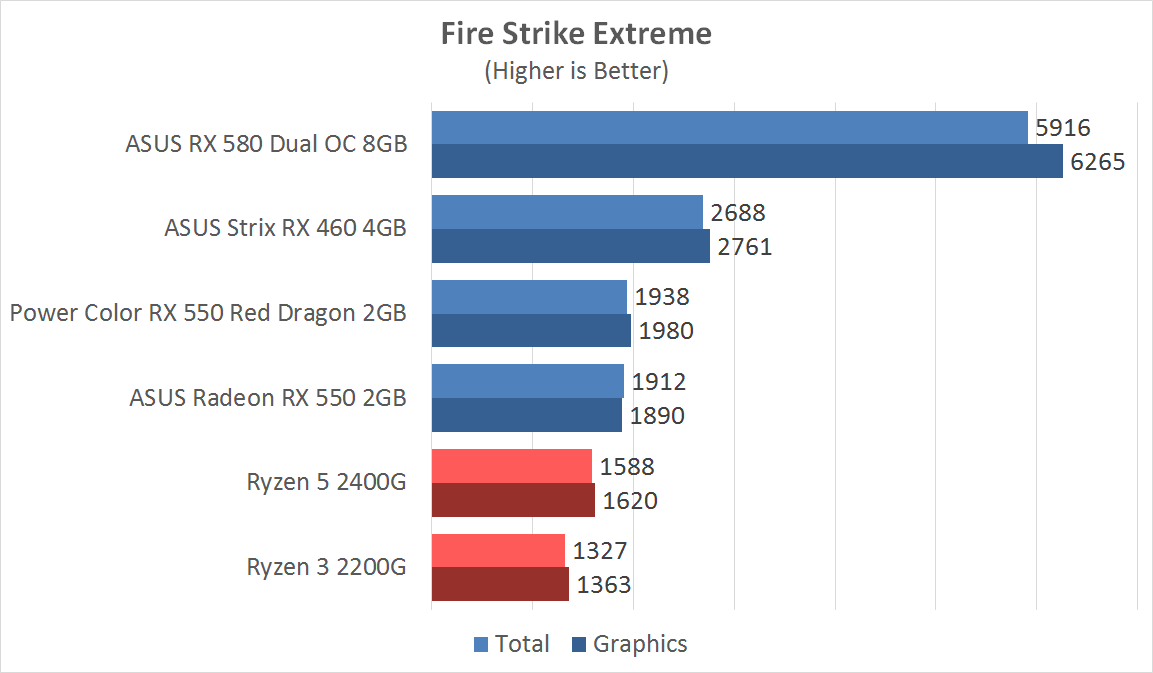
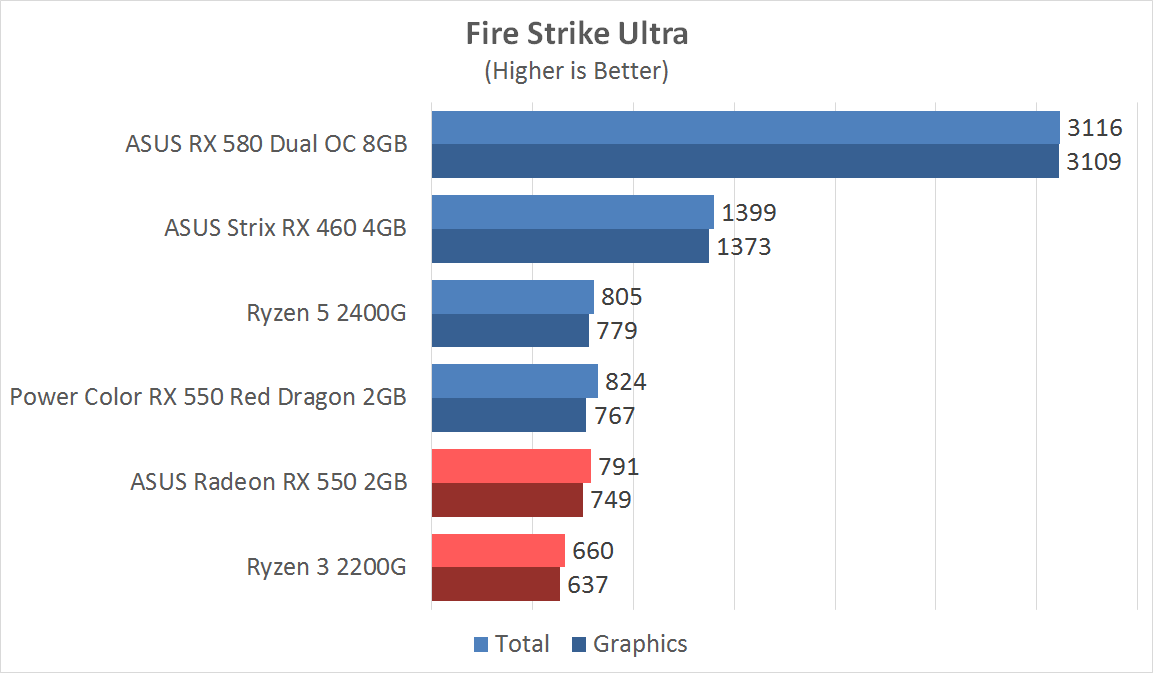
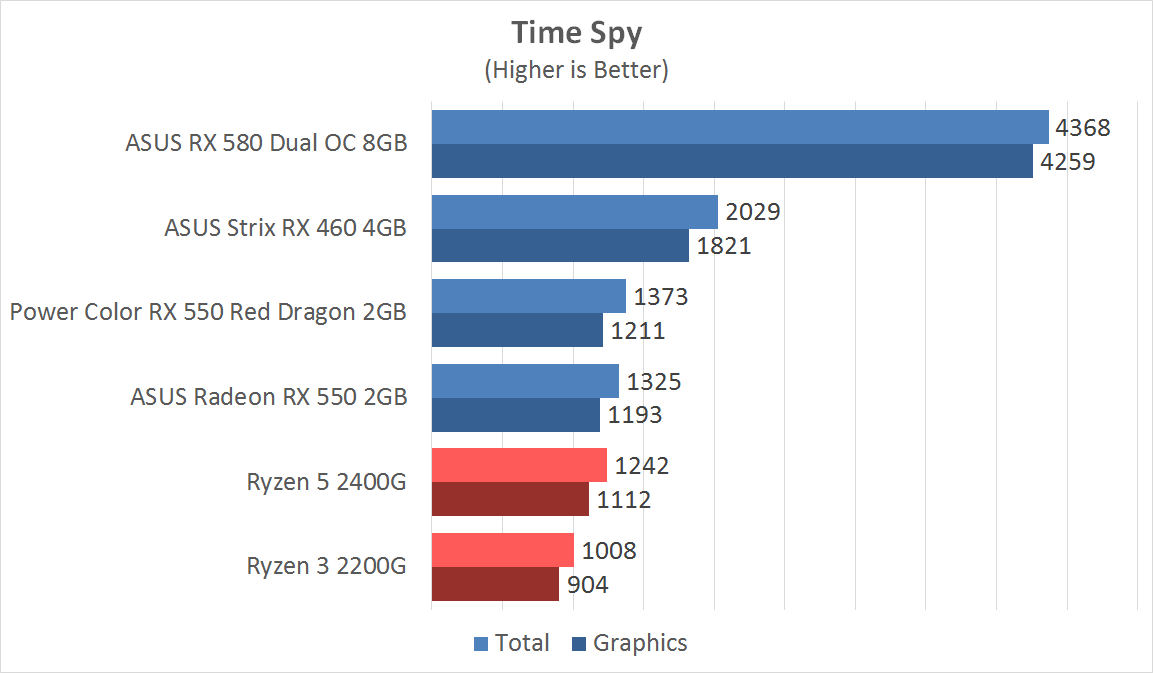

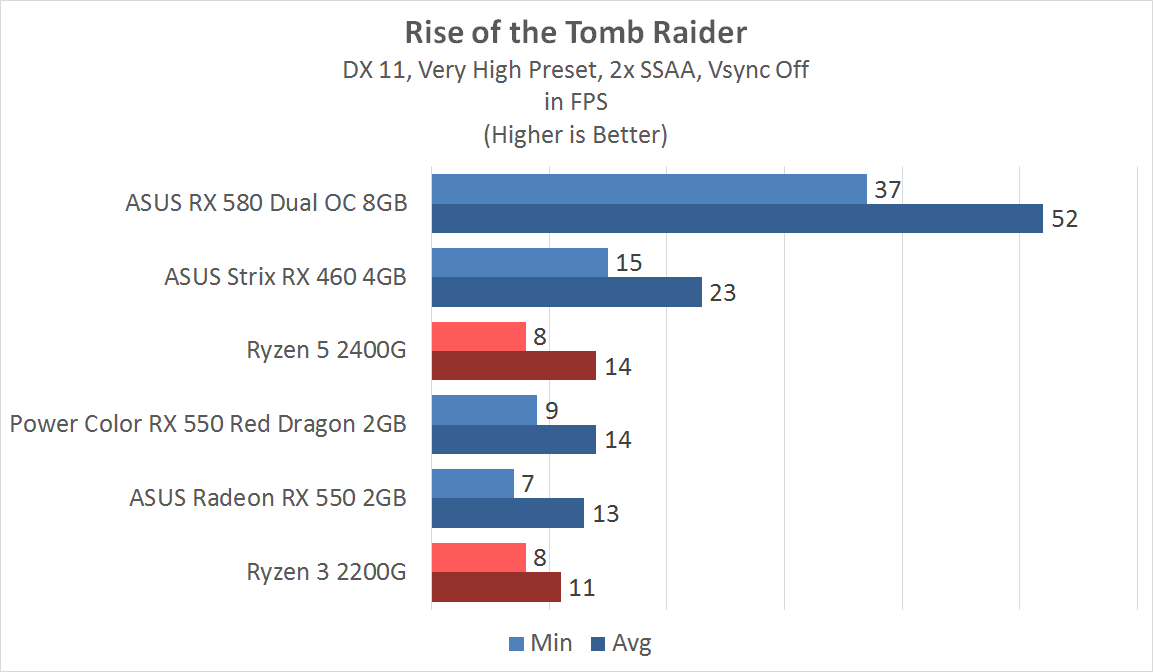


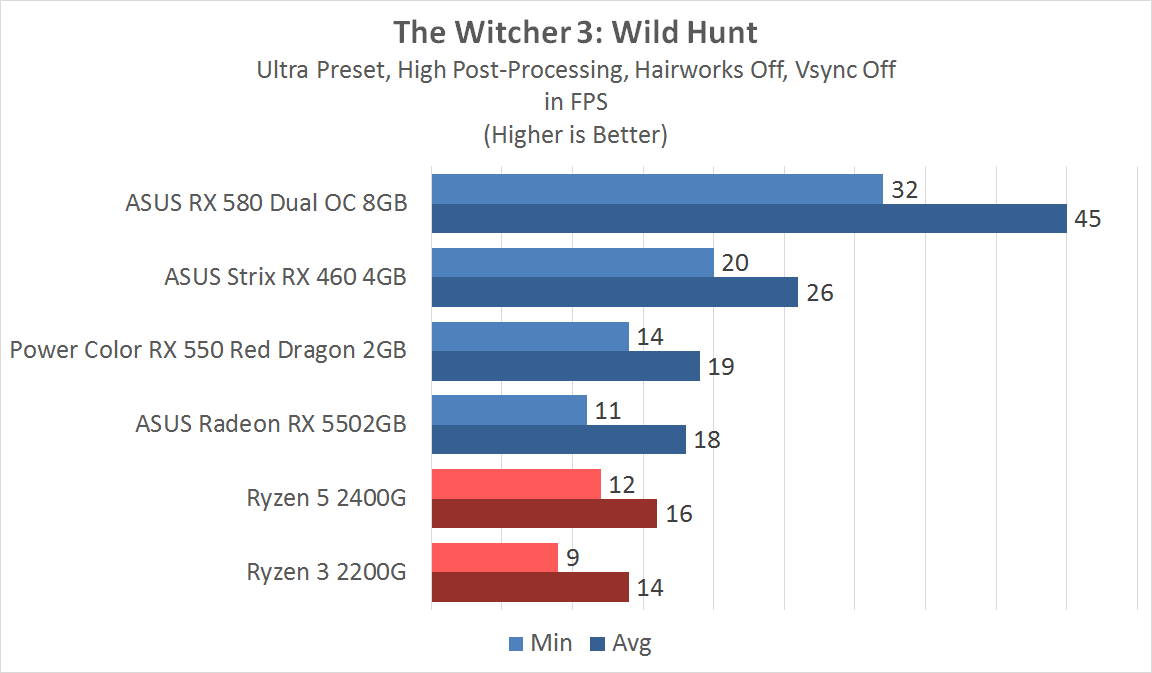
GPU benchmarks from both APUs are also expected. The numbers for the 2400G and 2200G sits just below the Radeon RX 550, which is a considerable achievement when take in the fact that most of our real-world gaming benchmarks were run at their highest settings at 1080p. Although you would need to turn down a couple of settings to get a better frame rate (such is the case in Hitman 2016 where the low RAM limit forced us to set the game at Texture Quality: Low, Shadow Maps: Medium, Shadow Resolution: Medium).
Temperature
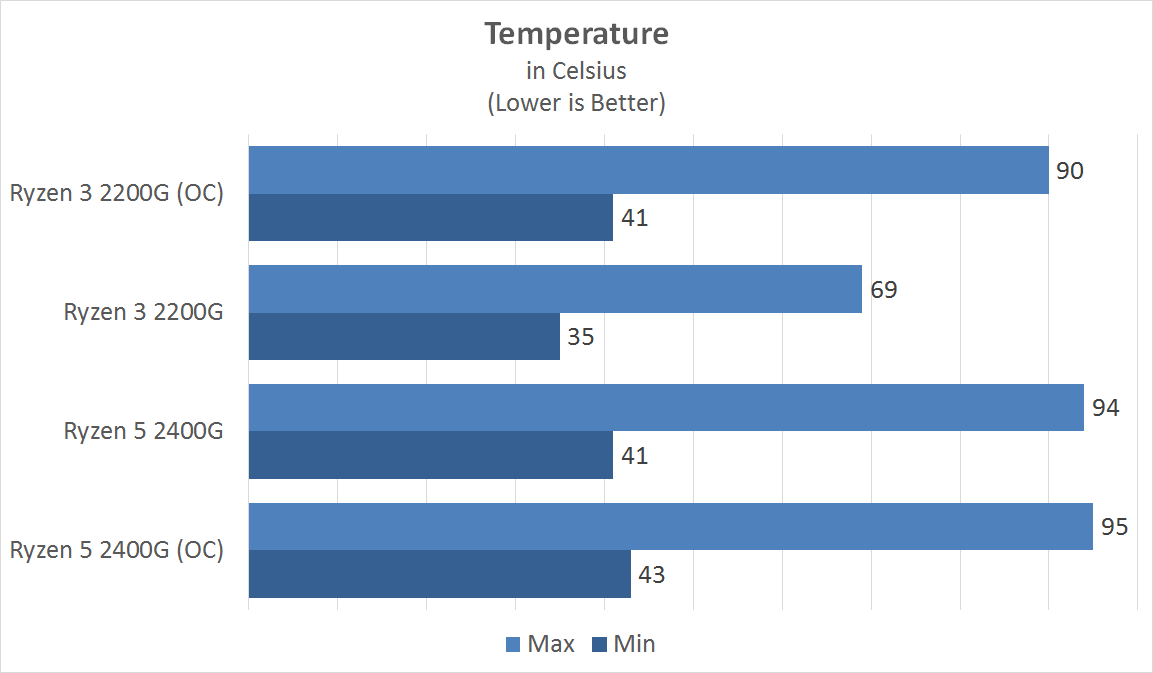
The Wraith Spire cooler included with both APUs does a decent job of cooling the processors. It does get a bit steamy, especially in when overclocking. You will need to get a beefier cooler if you want to overclock these APUs and expect them to live long.
Conclusion
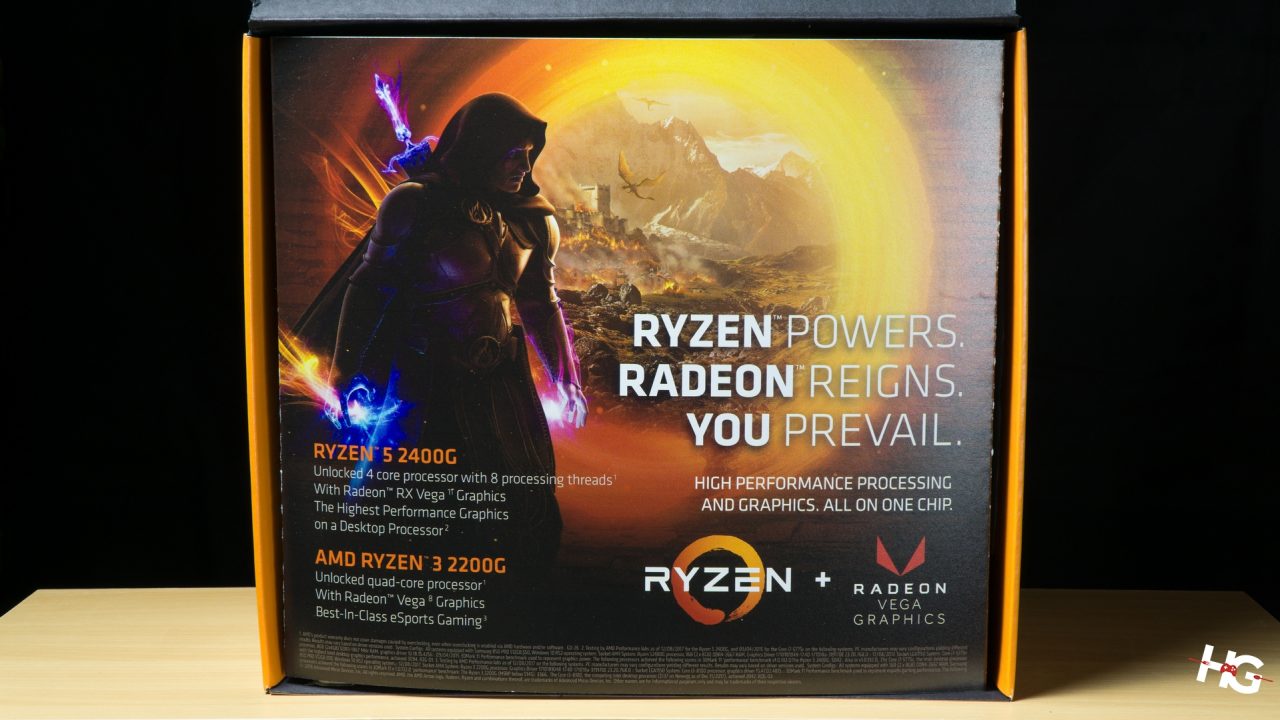
We never expected that Raven Ridge will overtake the discrete graphics market. We’d only hoped that it would be a decent alternative to entry-level gaming especially in today’s market where almost every GPU has been sold out due to mining.
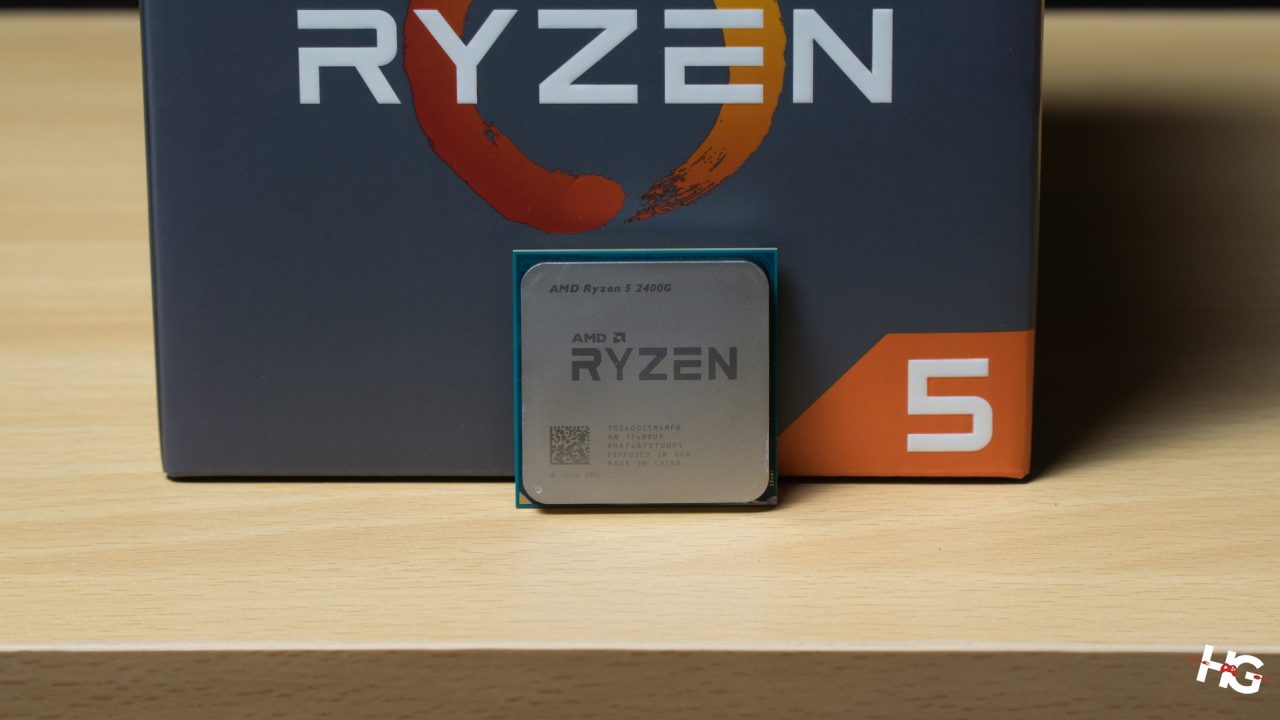
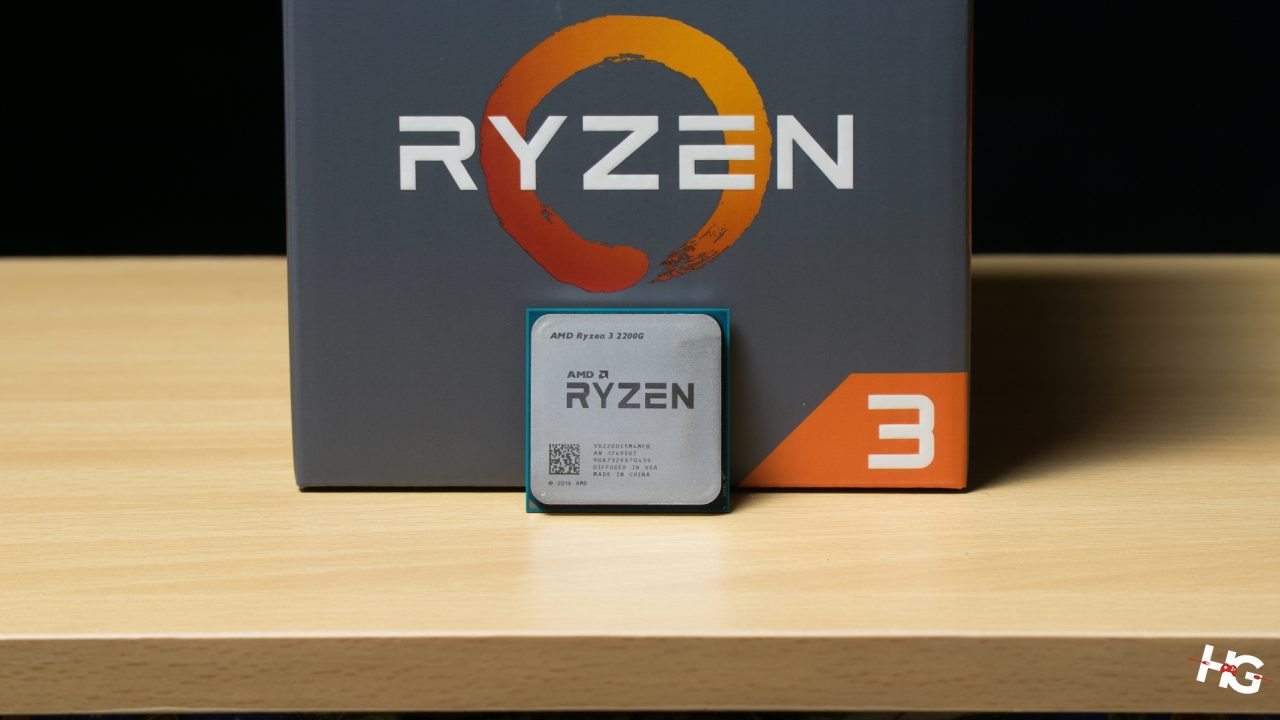
With these expectations in mind, we were not disappointed by the Ryzen 5 2400G and Ryzen 3 2200G. Both APUs performed well in system benchmarks as well as in gaming. Considering that they are priced at USD 169 (PhP 9,150) and USD 99 (PhP 5,735), respectively.
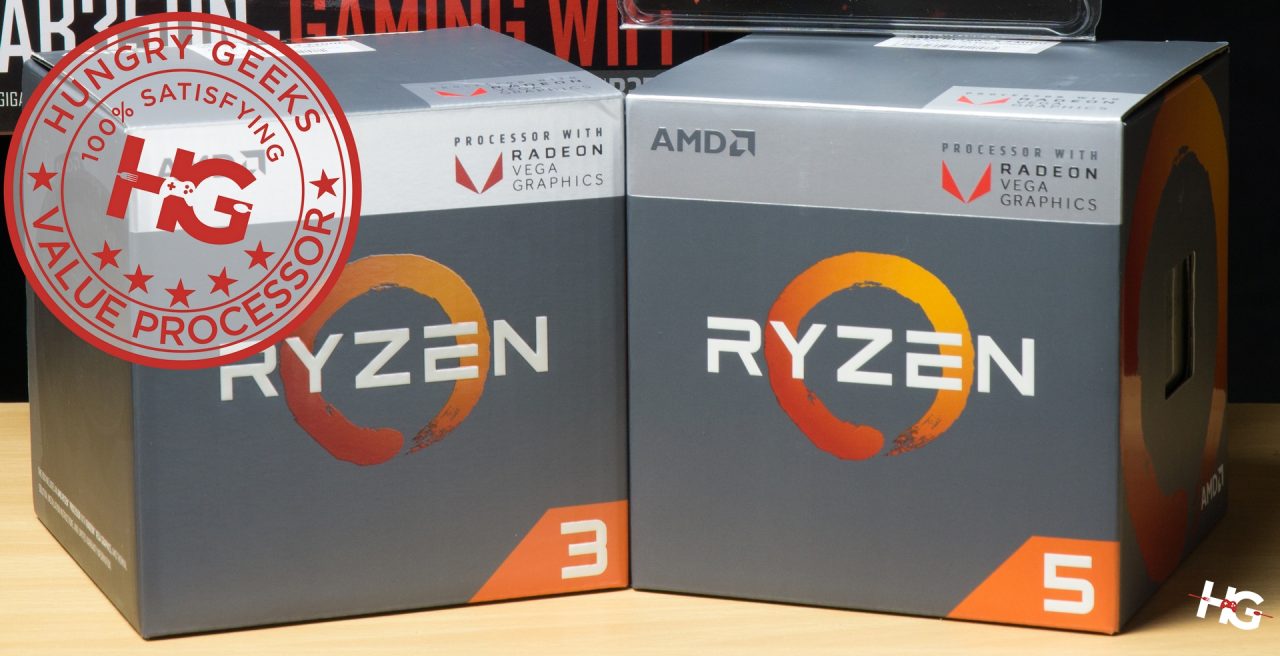
Now, what to choose? Well, if you have other tasks other than gaming like editing and rendering, then the Ryzen 5 2400G will be a better choice for you as it has 4 more threads compared to the 2200G. If you’re sole goal is entry-level gaming, then the Ryzen 3 2200G would be a smarter buy for you.
